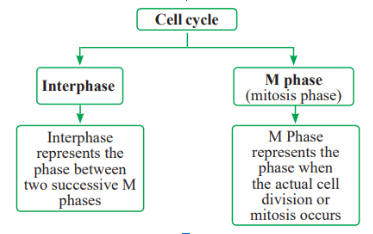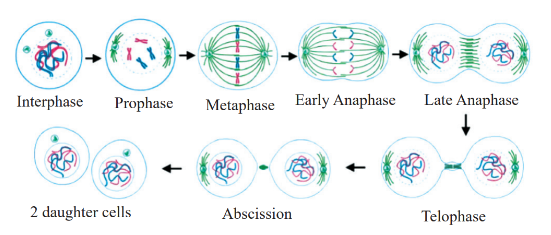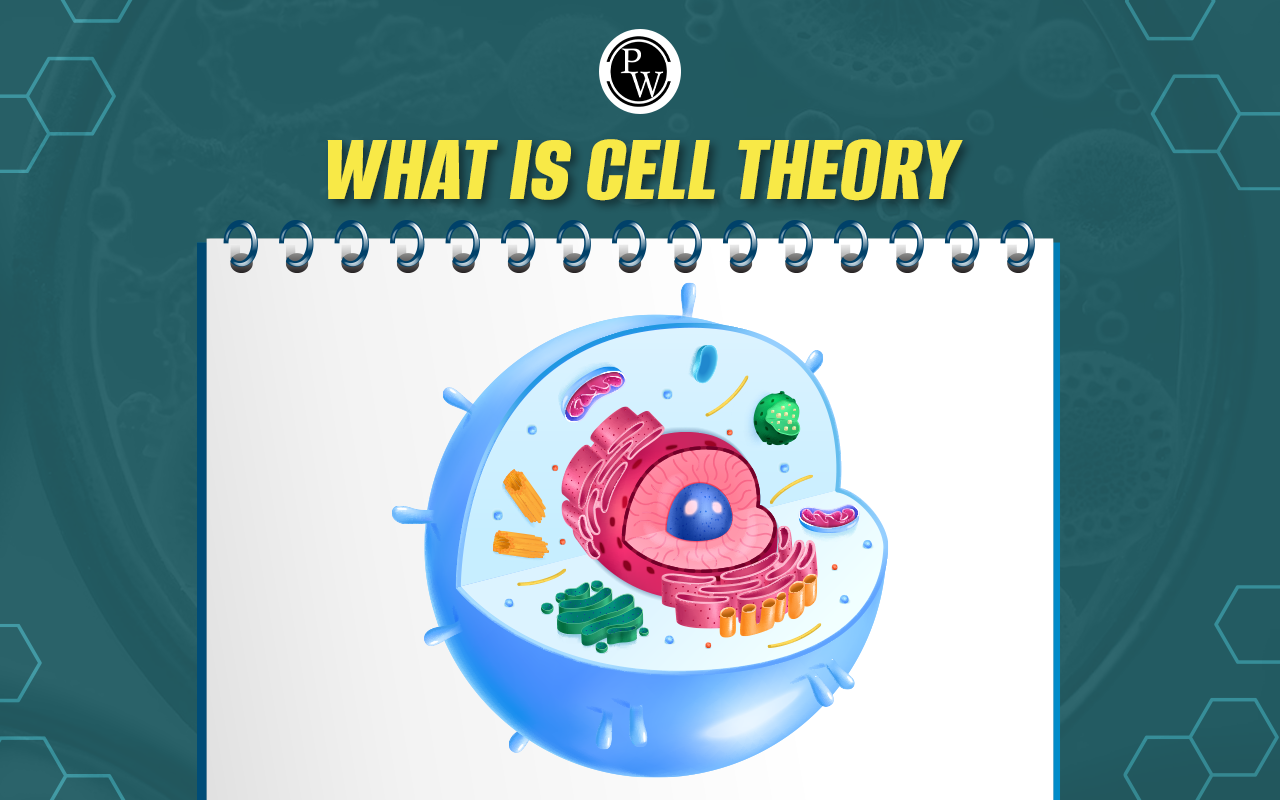
The phases of the cell cycle are essential steps that a cell goes through to grow and divide, creating two new cells. These phases ensure that the genetic material is copied correctly and distributed equally between the new cells. Understanding these phases is important for students preparing for the NEET Exam, as they form a key part of the NEET biology syllabus .

What are the Phases of Cell Cycle?
Cell division is a key process for all living organisms. During this process, a cell grows, copies its DNA , and divides into two new cells. The cell cycle is the series of steps a cell follows to duplicate its DNA, make the necessary cell parts, and divide. Although cell growth happens continuously, DNA replication occurs at a specific stage. This division ensures that the new cells (called daughter cells) receive complete and accurate genetic information. The entire process is controlled by genes.
The cell cycle has two main phases:- Interphase
- M Phase (Mitosis)

Interphase
Interphase is the longest part of the cell cycle. During this phase, the cell grows, duplicates its DNA, and prepares for division. It is often called the "preparation phase." Interphase is divided into three subphases:- G1 Phase (Gap 1): In this phase, the cell grows and performs its normal functions, such as producing proteins and energy. However, no DNA replication occurs yet.
- S Phase (Synthesis) : During the S phase, the cell duplicates its DNA. This means the amount of DNA in the cell doubles, but the number of chromosomes stays the same.
- G2 Phase (Gap 2): In the G2 phase, the cell continues to grow and prepares for the next phase, which is mitosis. Important proteins for cell division are produced, ensuring the cell is ready for the division process.
- Quiescent Stage (G0) : Some cells, like heart muscle cells in adult animals, do not divide and enter a resting phase called the G0 phase. In this phase, the cells remain active but do not divide unless needed for repair, such as after an injury.
M Phase (Mitosis)
The M phase is the part of the cell cycle where the cell actually divides. This division is called mitosis. In a typical human cell cycle, which lasts around 24 hours, the M phase only takes about one hour, while the rest of the cycle (called interphase) takes up more than 95% of the time. The M phase starts with the division of the nucleus, known as karyokinesis, where the chromosomes separate into two groups. After that, the cytoplasm divides, a process called cytokinesis. Although interphase is often called the "resting phase," it is not really resting. During interphase, the cell is busy growing and copying its DNA to get ready for division.Two Main Parts of the M Phase:
- Karyokinesis : Division of the nucleus.
- Cytokinesis: Division of the cytoplasm.
Stages of Karyokinesis
Karyokinesis is the stage of cell division where the nucleus splits to create two daughter nuclei. It marks the beginning of mitosis and includes several key stages: prophase, prometaphase, metaphase, anaphase, and telophase.Prophase
Prophase is the first stage of karyokinesis, occurring after the S and G2 phases of interphase. During interphase, the DNA is not clearly distinguishable. In prophase, the chromosomes begin to condense and become visible, while the centrosomes (which were duplicated earlier) start to move toward opposite ends of the cell.- Chromosomes condense and become visible as compact structures, each made up of two chromatids connected at the centromere.
- Centrosomes move to opposite poles, radiating microtubules (asters), forming the mitotic spindle.
- The Golgi complex, endoplasmic reticulum (ER) , nucleolus, and nuclear envelope disappear by the end of prophase.
Metaphase
Metaphase is the stage when the nuclear envelope completely dissolves, and the chromosomes spread out in the cytoplasm. By this point, the chromosomes are fully condensed and are best studied at this stage. Key Events in Metaphase :- Chromosomes align along the equatorial plane of the cell, known as the metaphase plate.
- Spindle fibers attach to the kinetochores, located at the centromeres of each chromosome.
- One chromatid from each chromosome is connected to spindle fibers from one pole, while the sister chromatid is attached to fibers from the opposite pole.
Anaphase
Anaphase begins when the centromeres of the chromosomes split, allowing the sister chromatids to separate. These separated chromatids, now referred to as daughter chromosomes, are pulled toward opposite poles of the cell.- Centromeres divide, and the sister chromatids separate, becoming individual daughter chromosomes.
- The chromosomes move toward opposite poles, with centromeres leading and arms trailing.
Telophase
Telophase is the final stage of karyokinesis, where the chromosomes reach the poles and begin to decondense. At this point, the nuclear envelope reforms around each set of chromosomes, resulting in two separate nuclei. Key Events in Telophase :- Chromosomes gather at the poles and start to decondense, losing their clear shape.
- Nuclear envelopes form around each cluster of chromosomes, creating two daughter nuclei.
- The nucleolus, Golgi complex, and ER reappear, signaling the end of karyokinesis.

Cytokinesis
Cytokinesis is the process that completes cell division by dividing the cytoplasm of a parent cell into two daughter cells, following karyokinesis (the separation of chromosomes).- In Animal Cells :
- A cleavage furrow forms in the plasma membrane.
- The furrow deepens, pinching the cell membrane inward until the cytoplasm is divided into two daughter cells.
- In Plant Cells :
- Cytokinesis begins with the formation of a cell plate at the center of the cell.
- The cell plate grows outward, merging with the existing cell walls to form a new cell wall, thus separating the daughter cells.
- Organelle Distribution : During cytokinesis, organelles such as mitochondria and plastids are distributed between the two daughter cells to ensure they function properly.
- Variations : In some organisms, karyokinesis occurs without cytokinesis, resulting in a multinucleate condition called a syncytium, such as in the liquid endosperm of coconuts.
Significance of Phase Cell Cycle
- The G1 phase is essential for cell growth and development.
- S phase ensures that the genetic material is duplicated, providing identical sets of chromosomes for each daughter cell.
- During the G2 phase, the cell continues to grow and prepares for mitosis by synthesizing proteins and organelles required for division.
- The M phase is essential for nuclear division, as it accurately segregates duplicated chromosomes into two daughter nuclei, maintaining genetic consistency.
- Cytokinesis is important for dividing the cytoplasm, completing the cell division process, and ensuring that both daughter cells receive the necessary organelles and resources.
- The phases of the cell cycle are critical for the growth and development of organisms, allowing them to transition from a single cell to complex multicellular structures.
- They contribute to cellular repair and maintenance, replacing damaged or dead cells to maintain tissue homeostasis.
MCQs of Phase of Cell Cycle
Q1. G1 phase is:-
- End of G2 phase.
- End of S phase and the start of mitosis.
- Start of S phase and the end of mitosis.
- End of mitosis and the start of S phase.
Q2. In the ’S’ phase of the cell cycle:
- The amount of DNA is reduced to half in each cell.
- The amount of DNA doubled in each cell.
- The amount of DNA remains the same in each cell.
- The chromosome number has increased.
Q3. Cells at the end of prophase, when viewed under the microscope, do not show:-
- Golgi body and ER
- Nucleolus
- Nuclear envelope
- All of these
Answers of MCQs of Phases of Cell Cycle
Ans1 . Start of the S phase and the end of mitosis.,| NEET Exam Important Links | |
|---|---|
| NEET Biology Syllabus | NEET Biology Diagrams |
| NEET Biology MCQ | NEET Biology Chapter wise Weightage |
| NEET Biology Notes | NEET Previous Year Question papers |
Phases of Cell Cycle FAQs
Q. What are the phases of the cell cycle?
Q. What are the different phases of the cell cycle?
Q. What are the two basic phases of the cell cycle?
Q. What are the 5 stages of the cell cycle?
Q. Which phase of the cell cycle is of the longest duration?
Q. What are the phases of the cell cycle?
Q. G1, G2, and S phases are seen in which phase of the cell cycle?










